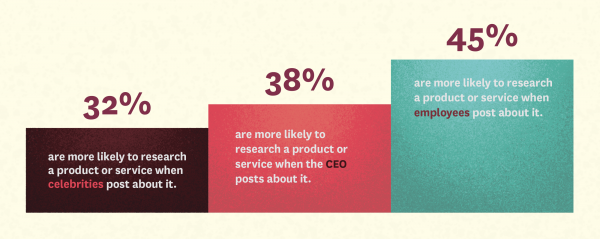
Let’s walk through a scenario. Imagine you’re a university student finishing up your senior year of college. You have a good idea of what you want to do after graduation; you’ve chosen your major, taken your courses and you’re ready to begin sending out job applications. The first place you turn to for ideas of companies where you can apply? Chances are, it’s social media – whether you realize it or not.
As you’re scrolling, you probably see friends, family and acquaintances you already trust posting about their jobs. They’re sharing about the company culture, job perks or client work. These posts might be the reason you decide to apply to one company over another. It could even be the reason you discover a job opening in the first place, at a company you may not have known about before.
These posts – a good chunk of them, anyway – aren’t by accident. Chances are, there’s an internal employee-advocacy strategy in place. The reason employee advocacy has become so popular is because, like most things in life, people trust their own friends’ and families’ opinions more than strangers’. A whopping 45% of consumers are more likely to research a product or service when employees post about it.
Interested in launching an employee-advocacy strategy like this at your own company? Start small, test and learn with a few key employees who will share their honest feedback with you, then pivot strategy and add more people as you learn.
Best practices for implementing an employee-advocacy strategy:
- Set goals and KPIs at the onset. Define what will make this program successful for your team. Why are you investing in this? Increased applications, social followers, content shares?
- Train your employees. Take the time to onboard a handful of employees with an employee-advocacy software (we use Bambu for similar programs at Bozell), review best practices and explain why this program is worthwhile for them.
- Find your core message. Provide ideas, content assets and core messaging that align with your goals.
- Consider an incentive program. Focus on sharing incentives in a way that encourages authentic posts, as opposed to making things seem mandatory or competitive.
- Now let go! The best part of employee advocacy is that, with a little help, it should be self-sustaining. Train your people and arm them with great assets, then let them do the talking for you.

If your brand is ready to think outside the box and reach a new audience that could drive more referrals, customers and exposure, consider employee advocacy. Invest in your company’s best asset – its employees – by empowering them with knowledge and content. Then give them the freedom to share about your brand organically.
Some stats to leave you with:
- 72% of social marketers are leveraging their employees as social media advocates. (Sprout Index Report, 2019)
- 84% of C-suite and VP-level buyers use social media to make purchasing decisions. (Skyward, 2019)
- Employees typically have social networks 10x larger than a corporate brand, and have double the click-through-rate of corporate shares. (LinkedIn, 2018)
- Companies with a successful employee-advocacy program are 58% more likely to attract and 20% more likely to retain top talent. (LinkedIn, 2018)
- Job-hunters say that a company’s current employees are their most trusted source of information and that social networks play a vital role in their job searches. (Hootsuite, 2019)



